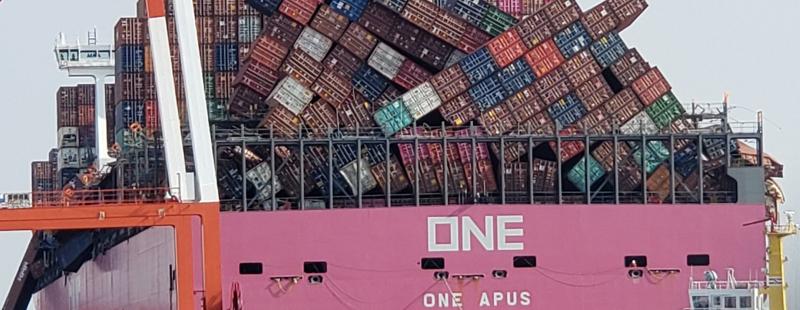 Last week, the container ship ONE Apus lost or had damaged over 1,900 containers in a storm in the Pacific. The lost or damaged containers representing close to 25% of the ship’s cargo. The casualty represents more containers than are typically lost in a year worldwide off all container ships, according to the World Shipping Council.
Last week, the container ship ONE Apus lost or had damaged over 1,900 containers in a storm in the Pacific. The lost or damaged containers representing close to 25% of the ship’s cargo. The casualty represents more containers than are typically lost in a year worldwide off all container ships, according to the World Shipping Council.
What happened on the ONE Apus? Why did so many boxes go over the side? It may be too soon to say. The ship just arrived in Kobe, Japan, and will be the subject of a detailed investigation as soon as the remaining damaged boxes are unloaded. That being said, one possible explanation is that ONE Apus experienced parametric rolling, a phenomenon that can induce violent rolling, particularly in large containerships.
The problem of parametric rolling has only been understood in container ships for roughly the last 20 years. In October 1998, the Post-Panamax container ship APL China began to roll violently by 30 to 40 degrees in a severe storm in the Pacific. It lost 406 containers, with 1,000 more damaged.
Then in 2003, the Maersk Carolina, a Panamax container ship, encountered a storm in the North Atlantic and began pitching and rolling violently. At one point, the ship rolled suddenly by 47 degrees. One hundred thirty-three containers were lost overboard, and 50 were damaged.
Both the APL China and the Maersk Carolina had encountered parametric rolling.
Parametric rolling can occur on ships in head or following seas. Beamy ships with significant bow flare and broad and flat sterns, such as modern, large container ships or car carriers are the most susceptible to parametric rolling. (It can also be a problem with fishing vessels, destroyers, and even some cruise ships.)
It appears that parametric rolling begins under very specific circumstances. The wavelength of the sea must be roughly the same as the length of the ship. The ship’s natural period of roll is equal to about twice the wave encounter period.
Once the sea begins to build and the wave height exceeds a critical level — the height which will allow the ship’s natural pitch/roll cycle to harmonize with the period of oncoming waves, the combined pitch, and roll of the ship can become quickly violent. Slowing the ship down reduces the roll damping, increasing the tendency to roll.
Perhaps counterintuitively, when conditions for parametric rolling exist, putting the ship’s head to the sea and reducing speed could make the rolling worse.
Traditionally stability criteria has been based on the static stability of a ship. The problem with parametric rolling is that it is a function of dynamic ship stability. IMO is currently developing Second Generation Intact Stability Criteria (SGISC) to address the particular risks of dynamic instability in five areas including parametric rolling.
What will the new standards mean? In a recent paper published in the Journal of Ocean Engineering and Technology, the authors concluded that “when new stability criteria are implemented, new ships are more likely to have reduced onboard cargo volumes in comparison to existing ships. In the case of existing ships, there is a great possibility that they will be forced to decrease their onboard cargo volume or operating speed, which is expected to have a large impact on future ship operations.”

Seems like overconfidence on the part of the captain may be to blame.
I amazed that naval architecture could be so archaic for large cargo vessels. Rolling is a form of resonance and the catastrophic case where external forces are perfectly in phase with the natural frequency of the vessel seems bound to occur occasionally. Modern ferries and passenger ships are fitted with active damping systems (usually called ‘stabilisers’) originally intended to improve passenger comfort, but I suspect they sometimes improve efficiency too. Do you know whether any container ships are eduipped with them?
Parametric rolling has only become a serious problem in containerships with the advent of the larger post-Panamax designs.
I am not familiar with any container ships with fin stabilizers. I have worked with one class of ships with anti-roll ballast tanks. The problem with fin stabilizers is that they are generally ineffective at slow speeds.
All this being said, I do note that Wartsilla has a note on its website saying: “Today, owners of other types of vessels, especially large containerships, are increasingly specifying fin stabilisers.”
This may be true but I have not heard of any container ships with fin stabilisers.